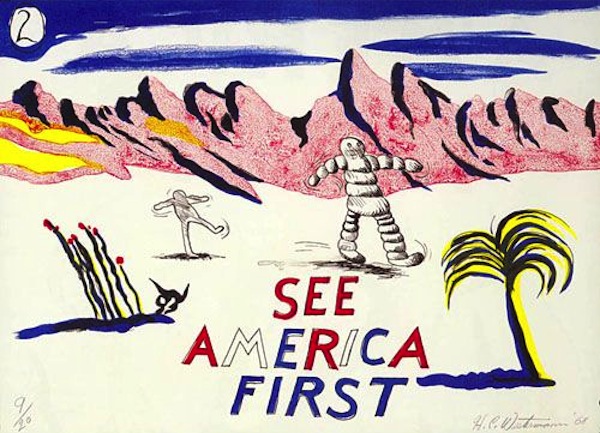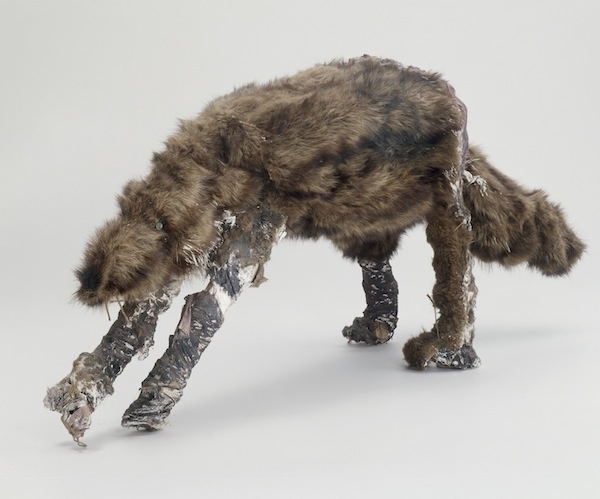Fuse Visual Arts Review: The Savage Cartoonistas at RISD — What A Nerve!
What Nerve! takes an innovative and fresh take on a little-noticed but piquant tributary of American art.
What Nerve! Alternative Figures In American Art, 1960 to the Present, at the RISD Museum of Art, Providence, Rhode Island, through January 2, 2015.

H.C. Westermann, “See America First” (1968). Photo: Courtesy of Lennon, Weinberg, Inc., New York.
By Tim Barry
Nostalgia is so embarrassing. You find yourself at a dinner party, fueled by a glass or two of Borsalino, regaling your interlocutors about the time you spent an hour and a half alone with Diane Keaton. “Doesn’t she still look great?” someone offers, and asks “when was that?” Umm….1992. I guess. Round about there.
So there’s a potential pitfall, the yawning abyss of memory-lane, to be reckoned with when organizing an exhibition of contemporary art from the era of Sputnik, Frankie Laine, and Spiro T. Agnew. Even when the parameters of the show take in work from the ’70s up to the early 2000s, taking a look back always carries the danger of casting a rosy, uncritical glow.
Co-curators Dan Nadel and Judith Tannenbaum mostly avoid this by taking an innovative and fresh take on a little-noticed but piquant tributary of American art, the savage cartoonistas. They selected works from four groups that are unrelated except by visual affinities and stylistic approaches — Funk (California circa 1967), The Hairy Who (Chicago, late ’60s), Destroy All Monsters (Detroit, ’70s) and Forceville (Providence, early 2000s). Then they proceed to highlight the connections of form and viewpoint by including works of six other artists who were influenced by the groups or, in some cases, themselves influenced the cartoonistas.
Take oddball H.C. Westermann’s loopy “See America First” color lithographs, which employ travel poster-art as a jumping-off point for dark and very funny forays into American sexual psychohistory. As an outsider artist showing at the Allan Frumkin Gallery in Chicago in the ’60s and ’70s, his work was a profound influence on Peter Saul, Karl Wirsum, Jim Nutt, Gladys Nilsson–all of whom are in the show.
Looking at Westermann, one can’t help but think of Mike Kelley, and Gary Panter–then two rooms later there’s a wall of each of their work! Having digested the exhaustive Mike Kelley retrospective at PS 1 in Queens, NY last fall, I thought I knew something of his history and development. But the Westermann connection was new.
Likewise the broad influence of Peter Saul, as the eighty year-old weirdo artist’s “Man In Electric Chair” (1966) sculpture leads us to the work of Jim Shaw, another American original. Shaw arrives as a hybrid; lead singer of Detroit’s proto punk-metal band Destroy All Monsters, he wields a DIY assault with photocopy art and other graphic works. His vector is horror movies, rock and roll gig flyers, and teen magazines such as Mad and Cracked.
The sheer strangeness of much of the work in this show is a strong point. Kudos again to the curators for ferreting out the truly bizarre, such as Joan Brown’s “Fur Rat,” a 1962 sculpture realized in raccoon fur wrapped around a chicken-wire armature. She then crudely slathered plaster on it’s extremities, arriving at a creature that looks ghastly in a not quite of-this-world way. It would not look out-of-place in a Joseph Beuys exhibition.

Joan Brown, “Fur Rat” (1962). Photo: courtesy of the artist.
“Fur Rat” was featured in the landmark Funk exhibition curated by Peter Selz at the University of California-Berkeley in 1967. In addition to Brown, William T. Wiley, Robert Arneson, Roy DeForest, Robert Hudson, Peter Saul and Peter Voulkos were in that show, and are all winningly represented here.
It’s a bit of a pity that Brown’s only item on the check-list here is the Rat. Her paintings, drawings (many depicting animals, and the animal behavior of humans) and folk-artsy sculptures are, sadly, missing from the various mainstreams of art-history. She seems ripe for a reappraisal.
This exhibition could have perhaps used more Joan Brown and less Gladys Nilsson. Though case is made for her inclusion here as a card-holding member of the Hairy Who union – and she’s married to Jim Nutt, the group’s strongest artist – the quality of Nilsson’s work simply doesn’t measure up to the others. It’s historically significant but thin work.
In contrast, the stirring, rich, and beautifully wrought paintings by Christina Ramberg seen here offer about all that can be asked of art. Veiled in mystery, brimming with sexual tension, they depart from a point first suggested by Fernand Leger and later carried forward by Richard Lindner. Seen in this context, there’s very little ‘Chicago’ about her images, with their meticulous formal constructions and brooding European tone. A Ramberg exhibition in a back-gallery at Boston’s ICA last spring fleshed out her impact more fully. Fail to seek her out at your own peril.

Christina Ramberg, “Probed Cinch” (1971). Photo: courtesy of the artist.
The gallery notes point out that “her images of women’s bodies in bondage provide a highly politicized retort to the macho sexuality in the paintings of William Copley in this exhibition.” This assertion is not entirely convincing. Granted, there’s little doubt that Copley, who died in 1996, was a prisoner of sex. If the sex depicted is macho, it is rendered via a soothing Matisse-like array of background patterns. And his works radiate a playful humor and a theatrical view of lust – his titles include “Behind The Green Door” and “The Seven Year Itch,” both from 1973.
The presence of the Forcefield group in this exhibition seems forced. Perhaps, because they studied at RISD, its members are granted local-hero status. Yes, some of their sculptures made it into a Whitney Biennial several moons ago – but the multi-media and video work displayed here falls into the category of strident student experiments.
Tim Barry studied English literature at Framingham State College and art history at the University of Massachusetts-Dartmouth. He has written for Take-It Magazine, The New Musical Express, The Noise, and The Boston Globe. He owns Tim’s Used Books, Hyannis, and Provincetown, and TB Projects, a contemporary art space, in Provincetown.
Tagged: Christina Ramberg, Dan Nadel, Gladys Nilsson, H.C. Westermann, Jim Nutt, Jim Shaw, Joan Brown, Karl Wirsum, Peter Saul, Tim Barry
